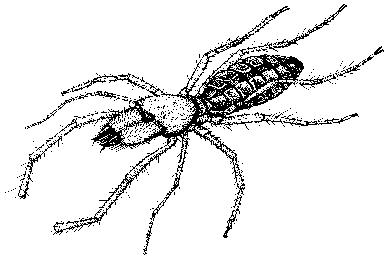 The Fierce Solpugid - May 1, 2002 Jeff Schalau, County Director, Agent, Agriculture & Natural Resources Arizona Cooperative Extension, Yavapai County The phone rang at the Cooperative Extension office and caller said "I have two weird looking scorpions in a jar, can I bring them in and have them identified?" Of course, we told them sure thing. By the time they reached the office, the jar contained only one "scorpion" and a pile of claws, legs, and body parts that used to be the other one. The critter wasn't a scorpion, but a solpugid (pronounced sole-pew-jid). They are Arachnids making them close relatives of spiders and are also known as sun spiders, wind scorpions, or camel spiders.  Solpugids somewhat resemble scorpions, but have no claws. Instead, they have "arms" called pedipalps in addition to their eight legs. The pedipalps have adhesive ends that allow them to catch and hold their prey. They can run very fast and when they do, they carry the pedipalps above their body. After chasing down and catching their prey with the pedipalps, the prey is crushed by the formidable fangs (called chelicerae). After killing their prey, they suck out the juice, and eat some of the fine particles, and discard the pulp. This explains what happened in the jar on the way to the Extension office. Solpugids somewhat resemble scorpions, but have no claws. Instead, they have "arms" called pedipalps in addition to their eight legs. The pedipalps have adhesive ends that allow them to catch and hold their prey. They can run very fast and when they do, they carry the pedipalps above their body. After chasing down and catching their prey with the pedipalps, the prey is crushed by the formidable fangs (called chelicerae). After killing their prey, they suck out the juice, and eat some of the fine particles, and discard the pulp. This explains what happened in the jar on the way to the Extension office.There are over 50 species of solpugids in the Southwestern United States. They are also found in Southern Europe where there are six known species. Most of them are 1-5 cm long (3/8-2 inches) and they can be yellow, brown, or black. I won't detail solpugid mating habits here, but from our frame of reference, their reproductive practices would probably be considered aberrant behavior. Suffice it to say that the male does not always survive the honeymoon. After mating, the female constructs a burrow where she lays 50-200 eggs. After the eggs hatch, the mother solpugid and the youngsters stay together for some time. During this time, she often captures prey and feeds the family. Did I say Solpugids are fast? I think this is one reason people are scared of them. They can really get up and go. Solpugids are usually nocturnal and eat a wide variety of prey. This includes but is not limited to termites, bees, bedbugs, mice, and lizards. There is a story about a Corporal in a Tank Battalion during World War II that kept a solpugid in a tin can on top of the tank. As the story goes, he fed it almost solely on scorpions. Solpugids are commonly considered to be venomous, but poison glands have not been found associated with the chelicerae. It has been suggested that poisoning might result from toxins being secreted from the bristle-like hairs near the chelicerae, but this has not been confirmed. Apparently, authentic cases of aftereffects resulting from a solpugid bite have been recorded, but these symptoms may have been caused by a bacterial infection of the wound. The solpugid's bad reputation is because of its fierce appearance. If you are accidentally bitten, wash with soap and water, then apply antiseptic to the wound. Outdoors they are beneficial and should not be killed. If you find one in your house, this tells you two things. First, you probably need to replace the weather stripping around your windows and/or doors. Second, you may have an insect pest infestation, such as roaches or termites, which attracted the solpugid to the area to feed. If you do encounter a solpugid indoors, quickly and carefully put it in a jar and observe it's impressive attributes. After that, release it to the outdoors where it can find a suitable dinner. The University of Arizona Cooperative Extension has publications and information on gardening and pest control. If you have other gardening questions, call the Master Gardener line in the Cottonwood office at 646-9113 or E-mail us at mgardener@verdeonline.com and be sure to include your address and phone number. Find past Backyard Gardener columns or submit column ideas at the Backyard Gardener web site: http://ag.arizona.edu/yavapai/anr/hort/byg/. |